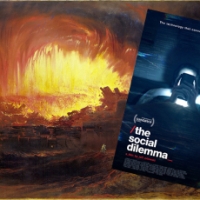My Favorite Books from 2018
Few will mourn the passing of 2018. To be frank, it was a year in which many disastrous and unfortunate things occurred. Granted, it takes a remarkable commitment to looking on the bright side to believe that 2019 will be dramatically better. Looking back at 2018 it is reasonable, and worthwhile, to recall the low points of the year and the events that demonstrated that things could always get worse. And yet, looking back at 2018, it’s also worth recognizing that it was a year in which many excellent books were published. Of course, as with 2017, it was easy to wind up just reading the news, or lengthy scientific reports, or the attention getting books that promised to provide insight into the political turmoil roiling the world. Yet in years such as 2018 wherein the world was both literally and figuratively on fire, there is much to be said for the sorts of books that provide you with the insight and context you need to make sense of the world.
2018 was a year in which we did not only need books to make us think (though we certainly needed those), but also books to think with, and books to think through. Luckily, 2018 saw the publication of many books that did all of those things.
What follows is a list of my ten favorite books from 2018. Admittedly this is a list of books that is highly reflective of my own interests and of the topics that were particularly on my mind in 2018. Thus, this list brings together a mixture of works in and around the history of technology, media studies, STS, disaster studies, history of science, environmental history, and a smattering of other fields. There is no fiction on this list, and though the books presented here tend to skew towards the academic sort, they are all highly readable and require of their readers only interest and curiosity, not scholarly specialization. These are the books that I kept thinking about after I read them, books I continually pulled off of my shelves in order to re-read underlined passages, and books that I found myself recommending repeatedly to others (or buying as presents to give to people during the holidays). Some of these books filled me with hope, some filled me with dread, but all of them reminded me that the way that the world is today is not the way that the world must be, or the way that the world always will be.
2018 wasn’t a great year. But at least a lot of great books came out.
Two quick notes: For the purposes of “end of year lists,” I consider books that were published in December to be contenders for inclusion on the following year’s “end of year” list. The books on this list are not presented in any sort of ranked order; instead, they are listed in reverse alphabetical order (by author’s last name) because that seemed like an amusing way to list them.
The Ecocentrists: A History of Radical Environmentalism by Keith Makoto Woodhouse (Columbia University Press)
“Environmentalists at their most useful have been skeptics, and groups like Earth First! Highlighted one of the environmental movement’s most enduring critiques: a questioning of material progress for its own sake and a mistrust of the presumed wisdom behind it.”
Throughout the early decades of the 20th century, the nascent environmental movement was fairly conservative – focused on preserving national sites so they could be enjoyed by those seeking wilderness. This romantic inflection, meant that by the time the 1960s counterculture started booming, environmental concerns were largely seen as preoccupations of the upper middle class. Yet, by the end of the 1960s groups of activists within the environmental movement pushed the cause of the environment in an increasingly radical direction: one that foresaw a human made ecological catastrophe on the horizon and doubted the ability of normal political action to avert this coming calamity. While prominent organizations like the Sierra Club sought to advocate for change through lobbying and pressure campaigns, the new generation of radicals increasingly abandoned such conventional strategies in favor of more confrontational tactics. At the core of much of this activism was an ecocentrist belief system which placed “nonhuman nature on an equal moral footing with people,” and which therefore distinguished these activists from those in the more mainstream environmental movement. Granted, this worldview could often lead to some rather misanthropic tendencies wherein an abstract “humanity” was blamed for ecological degradation instead of particular nations and economic systems – and these views led to clashes between radical environmentalists and other groups fighting for social and economic justice. These confrontational activists took the threat of impending disaster seriously and acted to put their lives on the line to defend the planet against those pillaging it – developing a range of important tactics for activism along the way. While self-consciously the radical fringe, these groups were not totally removed from the mainstream environmental movement, but they saw it as their job to move the Overton window on ecological issues. Before climate change had become a matter of major concern, these groups sought to develop and sustain a radical critique of industrial society within the environmental movement, one that saw the planet as more than a reserve of resources or a place to go hiking.
While, at some points, some may have been tempted to mock the radical environmentalists of groups like Earth First! as angry hippies, in the era of climate change their warnings about ecological collapse seem eerily prescient. Certainly, one can question some of their stances and some of their misanthropy, while also recognizing that the sorry state of the planet today attests to the fact that they weren’t wrong. The history that Woodhouse tells is fascinating and appropriately nuanced, he is critical of certain problematic viewpoints that were common amongst the radical environmentalists while remaining sympathetic to the sense of urgency undergirding their activism.
Read it because the environmental catastrophe the ecocentrists were worried about has arrived.
Freedom’s Laboratory: The Cold War Struggle for the Soul of Science by Audra J. Wolfe (Johns Hopkins University Press)
“In 1954, a scientist who spoke out against loyalty oaths was both taking a brave stand against political witch hunts and demonstrating to an international audience that (some) scientists in the United States had the freedom to criticize their own government. In the 1960s, US scientists who participated in international exchange programs with the Soviet Union were both building genuine friendships with their Soviet counterparts and collecting scientific intelligence.”
One of the most cherished ideas about science is that it is a field of inquiry built upon fidelity to the truth, and thus inherently distrustful of political meddling. This is the way that many scientists like to see themselves, and the way in which large swaths of the public like to see science and scientists as well. Yet, this view of science has a highly political history. As Wolfe demonstrates, the campaign to frame “good science” as apolitical was largely an outgrowth of Cold War tensions between the US and the USSR. Soviet scientists were portrayed as being servants of the state, performing science as they were directed to by political leaders – this was juxtaposed with scientists in the US who were portrayed as free to pursue pure science without needing to satisfy the whims of political powers. A war for the very “soul of science” was taking place as scientists (the world over) sought to make sense of the competing obligations with which they were forced to wrestle, and in this struggle scientists were themselves vocal advocates speaking out in defense of a particular view of what science should be. Consciously or not, scientists found themselves mobilized in the propaganda struggle of the Cold War, as their prominence and achievements helped undergird arguments over which economic model was superior. And lest one think the US always had the upper hand, Wolfe reminds her readers that the launch of Sputnik seemed to announce that impressive technical and scientific feats were possible under communism. Throughout this book, scientists are placed in their societal contexts and thus Wolfe is able to show how many of the scientists doing the “apolitical science” in the US were receiving funding from the CIA, and how many of the organizations touting the importance of “free” science were part of the US’s propaganda machine. It was not merely that scientists in the US were free to pursue whatever research they desired (after all, they were still highly reliant on funding, and the scientific fields remained dominated by white men), but that this image of the American scientist as being free to investigate whatever they wanted served a political purpose.
In the book’s epilogue, Wolfe reflects on the “March for Science” and comments that “the dream of a transcendent science, free from politics, remains alive and well.” And yet what her book masterfully illustrates is that this idea of “a transcendent science, free from politics” is itself the result of a politicization of science – that the idea has become dominant today does not mean that it always was so. A fascinating and troubling story, Wolfe’s account of how “the solution is not to throw out a belief in ‘science,’ with its orientation toward problem-solving and real-world systems, but to work to make the best parts of science better” – is a much needed rallying cry.
Read it because, even if the Cold War is over, science is still political.
Anti-Social Media: How Facebook Disconnects Us and Undermines Democracy by Siva Vaidhyanathan (Oxford University Press)
“When we make a cult of technology and welcome its immediate rewards and conveniences into our lives without consideration of the long-term costs, we make fools of ourselves.”
Mark Zuckerberg did not have a particularly good 2018. Sure, he’s still one of the world’s wealthiest people, and it’s likely that he’s only going to grow richer in 2019 – but in 2018 he found himself hauled in front of Congress where he squirmed uncomfortably as he was peppered with questions, and the year ended with yet another avalanche of negative press about the company he started. In 2018, it became acceptable to ponder aloud “what is wrong with Facebook?” And to that the best answer was supplied by Vaidhyanathan: “the problem with Facebook is Facebook.” With over 2 billion users and command of other popular social-media platforms (Instagram, WhatsApp), Facebook has become an important feature of daily life for many people. Facebook allows users to upload pictures, keep up with family, reconnect with old acquaintances, and express what they “like” – and it has succeeded by offering a pleasurable and addictive experience. Yet even as it monetizes the vast surveillance apparatus it has constructed, Facebook flattens context to blur the difference between reputable news sources and fringe sites, creates filter bubbles, and it helps hateful and hyperbolic content spread. And these problems are not limited to the US, as Facebook has become synonymous with the Internet in many parts of the world. Furthermore, even as Facebook has come under scrutiny for its role in disseminating propaganda in the 2016 US election and in the run up to the Brexit vote – the platform has been utilized by authoritarian leaders and parties in many parts of the world. For a time there was a large amount of hope and hype that surrounded Facebook, and celebrated the ways in which it would transform the world for the better – but in 2018 it has become impossible to take such claims seriously. Every day, Zuckerberg looks less like a visionary, and more like Dr. Frankenstein – desperately trying to control the monster he unthinkingly created and proceeded to lose control over. Ultimately, as Vaidhyanathan makes clear, the problem with Facebook is Facebook.
It seems as though there was a new Facebook scandal every other week in 2018, but hovering around many of these scandals was a sort of inured acceptance. Yes, Facebook is bad, but we’ve just gotten used to that. And for too many people the downsides of giving up Facebook outweigh the ability to stay in touch with friends and family. Vaidhyanathan has written an excellent analysis of the company that considers how the company has come to be what it is and how it operates internationally. If you’re looking to understand Facebook (which, frankly, you need to) this book is a must read.
Read it because the problem with Facebook is Facebook. And until people understand that, Facebook will continue to be a problem for all of us.
Algorithms of Oppression: How Search Engines Reinforce Racism by Safiya Umoja Noble (New York University Press)
“An app will not save us. We will not sort out social inequality lying in bed staring at smartphones. It will not stem from simply sending emails to people in power, one person at a time. New, neoliberal conceptions of individual freedoms (especially in the realm of technology use) are oversupported in direct opposition to protections realized through large-scale organizing to ensure collective rights.”
What are the biases at work behind your search results? This is one of the core questions that Noble explores in this essential book which explores one of the key tools that upon which people have become reliant for enjoying some semblance of control over the digital world (by being able to search within it). Yet, these systems simultaneously enhance the control enjoyed by certain companies while reinforcing certain toxic narratives. Noble refers to the systemic racism embedded in systems such as search engines as “algorithmic oppression” and she explains that this “is not just a glitch in the system but, rather, is fundamental to the operating system of the web.” While the key element of Noble’s project is exposing the ways in which search engines perpetuate racial bias, a secondary theme of her book is in demonstrating the ways in which the largest search companies (namely, Google) have become dominant information brokers. Far from being a neutral tool for swiftly helping Internet users find that for which they are looking, search algorithms drive users towards that which the maker of the search engine wants them to see. By focusing on “algorithmic oppression,” Noble reveals the ways in which search engines are not governed by technological determinism; rather, there are human biases, and economic decisions, that are at work in creating and maintaining the forms of computerized control that are designed into these algorithms. Even though computers, and related technologies, are often praised for their liberatory potential, Noble ponders the ways in which an ethos of control and certain repressive biases have become common in computers. An important step towards remedying these biases would be for companies like Google to hire a less white and less male set of staffers, but Noble also explores the extent to which certain repressive features are at the very core of computing. As Noble notes “at the very historical moment when structural barriers to employment were being addressed legislatively in the 1960s, the rise of our reliance on modern technologies emerged,” and as Noble’s book makes clear it is impossible to seriously argue that modern computerized technologies have eliminated bias. Indeed, they may have played a major role in reinforcing it.
Search engines have become part of the essential infrastructure for navigating the digital world, and phrases like “Google it” have gone from being technologically chic to simply banal. Yet, the items that populate your “results” page are anything but neutral, and repeatedly show the impact of the technological society being built by a subset of people who are not truly reflective of society’s diversity. While there has been much sound and fury from Congress about Google’s perceived biases, Noble’s book is an essential look at the way in which search engines reinforce reactionary societal biases. Goodness knows, if more members of Congress had read Noble’s book, they would have been able to ask better questions.
Read it so that you can really make sense of your search results.
Kropotkin: The Politics of Community by Brian Morris (PM Press)
“In this climate of ‘apocalyptic despair’ and given the virtual absence of any credible alternative to neoliberalism, it behooves us, I think, to seriously reconsider the social and political writings of Kropotkin and the social anarchist tradition to which he belonged.”
Though Peter Kropotkin was born into the Russian aristocracy in 1842, his funeral procession in Moscow in 1921 stretched for five miles as tens of thousands gathered to pay final respects to the anarchist formerly known as prince. Having enjoyed a scientific education due to his privileged upbringing, Kropotkin was an accomplished geographer and naturalist who sought to counter the Hobbesian thesis on the “survival of the fittest” by emphasizing the important role that sociality – or as he put it “mutual aid” – played in the evolution of species. Yet, Kropotkin is not principally remember for his scientific work but as one of anarchism’s most important theorists. His thinking combined a deep opposition to capitalism, social oppression, and the state, with a hopeful vision of a future society based on the principles of voluntary association, communal self-management, and (most importantly) the idea of mutual aid. Furthermore, Kropotkin grounded his beliefs in an ecological vision that emphasized that such a society would necessarily be one that did not despoil the planet; and he envisioned the ethical underpinning of this society as being a mixture of sociality, justice, and magnanimity. A theorist of, and advocate for, anarchist communism – Kropotkin is a key thinker in the political tradition that believed that the freedom of the individual was incumbent upon their being part of a community of equals. Though there are certainly utopian threads within Kropotkin’s work, his concerns were also based in a realistic assessment of the challenges ahead, as he emphasized that one of the key tasks for revolutionaries would be to figure out how to feed the people. While Kropotkin looked backwards to tribal societies and the medieval societies for early examples of the principle of mutual aid in action, he was not simply a romantic and he did not seek a return to an imagined past, rather he sought to build a society that took hold of what was best in human civilization while rejecting the tendencies that served to enrich the few to the detriment of the many. As Morris argues in this phenomenal introduction to this complex and vital thinker, in our present moment of political impasse and environmental crisis Kropotkin’s concepts remain revelatory and important.
Over the course of his life, Kropotkin wrote numerous books and mountains of articles on topics ranging from evolution to the abolition of prisons to literature to the need for revolution – and in these works Kropotkin always endeavored to make his thought accessible to the average reader. With this book, Morris has penned an excellent introduction to Kropotkin’s thought that demonstrates that Kropotkin’s ideas are far from outdated. Morris skillfully defends Kropotkin against lazy critiques that dismiss of him as a utopian and a romantic, while introducing Kropotkin’s core thinking in a way that will be comprehensible to those new to Kropotkin and those seeking to burnish their knowledge. Kropotkin never lost hope, and his ideas provide much needed counter to despair.
Read it if you still believe that a better world is possible.
Re-Engineering Humanity by Brett Frischmann and Evan Selinger (Cambridge University Press)
“To escape humanity’s techno-social dilemma and the slippery-sloped path we are on, we need a reasonable dose of rigorous technology criticism, grounded in theoretical frameworks and empirical research drawn from a wide range of disciplines.”
At the core of this important assessment of what technology is doing to us and to our world, is the concept of “techno-social engineering.” By this concept the authors mean the “processes where technologies and social forces align and impact how we think, perceive, and act.” Assuming a skeptical position couched in a highly humanistic position, this book takes a highly critical look at what is being wrought by “techno-social engineering” to argue that this process of engineering is resulting in a humanity that is increasingly machine like. Indeed, the book even offers a sort of modified Turing Test to check for times not when a computer is indistinguishable from a human, but for when humans are behaving in ways that are indistinguishable from machines. Frischmann and Selinger engage with the concept of the “slippery slope” to discuss the ways in which humanity finds itself sliding faster and faster towards a certain technological direction – for as humanity comes to be increasingly reliant on complex technological systems it becomes harder and harder for people to imagine extricating themselves from these systems (or turning them off). Another important concept that the authors explore is the idea of “creep,” by which a technology that originally appears in a particular context gradually comes worm its way into every aspect of a person’s life until its omnipresence becomes taken for granted. Though technologies are often touted for the ways in which they will free people, Frischmann and Selinger rigorously engage with the ideas of freedom and free will as important human ends which, under the guise of technological enhancement, are coming under assault by the very tools that are supposedly there to aid people. Freedom is constrained when people come to be increasingly reliant on devices that enact control over their lives, devices that remain black boxed, and which push and prod users. What is needed here is a “freedom to be off,” which is all the more essential to fight for given the degree to which it is antithetical to the version of freedom being sold along with shiny new high-tech devices.
At the core of Frischmann and Selinger’s highly engaging book is a very troublesome question: are we becoming more like machines? This is a concern that critics of technology have been wrestling with for years, but looking out upon computers, fitness trackers, social media (and more) – Frischmann and Selinger seem to suggest that we have reason to worry. What they put forward is a clear and persuasive ethical vision that demonstrates an enduring faith in human dignity and affirms that freedom built upon technologies of control (over which we have little actual control) is freedom in name only. And the call for “the freedom to be off” represents a vital and worthwhile challenge to our techno-socially engineered world.
Read it because, like it or not, you can’t escape techno-social engineering.
The Future as Catastrophe: Imagining Disaster in the Modern Age by Eva Horn (Columbia University Press)
“Imagined disasters illustrate potential dangers and risks that we cannot fully grasp. The imagination of disaster seems to shed a light through the fog of an overly complex world, to make things manageable and to promise to reveal an essential truth.”
The shift from a religious perspective that sees the world ending due to an act of God to a modern conception that sees the world ending as a result of human action marks a dramatic alteration in the way that humanity has viewed itself in relation to the world and the future. And these fears of the world being destroyed by humanity, according to Horn, have their roots in the Enlightenment – at the very moment of increasing faith in the idea of progress, some thinkers began to warn that unlimited progress would inevitably lead to collapse. Such fears found their apotheosis in the Cold War as the threat of impending nuclear war made the concept of a human caused apocalypse seem frighteningly plausible. Yet today, though the threat of nuclear war still exists, the apocalyptic threat has shifted to the “catastrophe without event” in the form of climate change. As Horn explores in this book, it is not simply that humanity has become aware of its own destructive powers but that people interact with their apocalyptic anxieties through a variety of recurrent cultural forms. Figures like “the last man,” the woebegone figure who beholds the ruins of civilization and is able to render a final human judgment on human folly, are key tools by which people think through doomsday scenarios. While in contrast to “the last man” stands the figure of “the survivor/survivalist” who anticipated the coming collapse and who seeks not only to endure but to thrive amidst the wreckage. Prophets represent another essential archetype of apocalyptic characters, though what defines these prophets is precisely that (like Cassandra) they are right even if none believe them until it is too late. Focusing her attention on popular representations of catastrophes – including: The Road, Take Shelter, 12 Monkeys, White Noise, Dr. Strangelove, a host of disaster films (and many others) – Horn discusses the ways in which these imagined disasters provide a space for people to confront their apocalyptic anxieties. Though fictional, these works make the end of the world knowable and understandable. Yet, Horn is aware of the dangers of apocalyptic romanticism (in which the world of ruins seems preferable to the world of today), and is also aware of the ways in which watching actors navigate the desolate future can prevent us from taking proper action to prevent those futures from occurring.
Moving from Lord Byron’s poem “Darkness” to The Road, Horn provides a panoramic view of fictional catastrophes, emphasizing the ways in which they are reflective of (or prefigurative of) real catastrophes. While recognizing the inherent silliness of some works of fiction depicting catastrophes, Horn is carefully attuned to what we can learn from engaging with these works, even as she considers why it is that we are drawn to such works in the first place. A wonderfully unsettling book, Horn argues that we need to take imagined disasters seriously as they can prepare us for the real disasters ahead.
Read it before you watch or read any piece of disaster or dystopian content.
Automating Inequality: How High-Tech Tools Profile, Police, and Punish the Poor by Virginia Eubanks (St. Martin’s Press)
“Technologies of poverty management are not neutral. They are shaped by our nation’s fear of economic insecurity and our hatred of the poor; they in turn shape the politics and experience of poverty.”
Often the groups who find themselves experiencing the cutting edge of new technological systems are those least able to challenge these systems. In Automating Inequality Eubanks deploys idea of the “digital poorhouse” to describe the computerized systems that police and suppress impoverished Americans. Within “the digital poorhouse” the people working within institutions that manage poverty (such as social workers) are gradually replaced by new high-tech tools. And though those working for these institutions may have at times been biased, these computerized systems have biases built into their code. Several different systems that make up facets of “the digital poorhouse” are explored, including a system for managing Medicaid in Indiana, a platform for keeping track of the homeless in Los Angeles, and a predictive risk modelling system for the city of Pittsburgh. In none of these cases is technology the determinant, rather in each case the technological system is the manifestation of particular sets of human biases that led to the creation and deployment of these systems. Thus, there may be a genuine ethical difference between Indiana’s, then governor, Mitch Daniels desire to have a system that would push people off of Medicaid, and the hope that the system in Los Angeles would help connect homeless people with beneficial services. Yet, in both cases the result is ultimately rather similar: control over people’s lives being handed over to opaque algorithms. This represents not only a shift in control, but also an abandonment of social responsibility reflective of the American response to poverty, namely: “we see it, and then we look away.” The “digital poorhouse” is a grim harbinger for as these systems are scaled up it become harder to shut them down. While Automating Inequality carries a moral argument about what we owe to each other, it also features a stark warning, “yesterday, we experimented on the corpses of the poor; today we tinker with their futures.” Eubanks warning is clear: the systems which are tried out upon the poor, will eventually be unleashed upon everyone else.
Much of the excitement around new technologies tends to cluster around new types of “smart” devices or promises about how we’re one step away from flying cars. Lost in this are the stories about new high-tech systems that are introduced within cities and states for the purposes of managing people, and as Eubanks discusses these are often the sorts of people that go unseen and ignored. What Eubanks shows in disturbing detail is the way in which the systems that are supposedly designed to lift people up, really serve to keep them down, and the ways in which our society’s bias against the impoverished is built into the systems that regulate the poor. As Eubanks damningly puts it, “Our ethical evolution still lags behind our technological revolution.”
Read it because high-tech social control is already here, you just have to know where to look.
Artificial Unintelligence: How Computers Misunderstand the World by Meredith Broussard (The MIT Press)
“There’s a saying: When all you have is a hammer, everything looks like a nail. Computers are our hammers. It’s time to stop rushing blindly into the digital future and start making better, more thoughtful decisions about when and why to use technology.”
There is a steady deluge of articles that promise their readers that soon “AI will do X,” that “computers will do Y,” and that “a new smart device will do Z” – but despite their eager prose, many of these articles tend to be rather vague on how these significant changes will actually occur. Broussard sets out to dispel many of the myths that are told about computers, in particular the tales that frame computers as being much more capable than they truly are. Much of this problem stems from “technochauvanism…the belief that tech is always the solution,” this is an idea that is closely linked to certain libertarian attitudes within Silicon Valley, but it is a belief that has gained wide acceptance. Drawing upon her background in computer science, Broussard provides an account of how computer programs and AI actually work – emphasizing the tasks that they excel at and those where their capabilities are lacking. A key factor that is returned to throughout the book is that there are human beings at work behind these machines – they create the systems, they supply the data, and so forth. Furthermore, it is human fantasies around and about technology that lead to many of the misunderstandings about what these machines can do. A careful contrast is drawn between the real state of AI and the technochauvinistic fantasies surrounding it. Indeed, “coming soon” has become a sort of tech shorthand for things that are still very far away. Underscoring the analysis of the state of technology is an ethical emphasis that highlight the ways in which technology often reinforces the status quo even as it promises to fundamentally reshape society. While computers are clearly very good at providing solutions to certain sorts of problems, the danger is that an overly enthusiastic embrace of computers sees people rushing to reshape the world to fit the needs of computers instead of reshaping computers to fit the needs of the world.
It is always risky when an author tries to explain the way that code functions, but Broussard skillfully provides an explanation not just of how code works but why it matters. This book simultaneously delivers a careful assessment of the actual state of AI, unpacks the inner workings of computers, and highlights that while computers are very good at some things they simply aren’t good at everything. An excellent and enjoyable look at computers and AI, this book reveals that the stories we tell about AI and computers say more about us than they do about the computers.
Read it before you read another article with “AI” in the headline.
The Collected Poems of Bertolt Brecht by Bertolt Brecht, translated and edited by Tom Kuhn and David Constantine, with the assistance of Charlotte Ryland (Liveright Publishing Company)
We fly over the mountains
As though there was nothing to it
Great are the works of humans!
But bread for all? We can’t do it.
Child, ask why
Can we not feed the hungry.
Much of Brecht’s fame remains linked to his many dramatic works such as The Threepenny Opera, Galileo, and Mother Courage – but he was also a prolific poet, writing hundreds of poems. While Brecht’s dramatic works (and his writings on drama) attested to his political commitments and values, his poetry captures his keen personal perspective as he endured life in what he frequently referred to as “the darkest times.” In his poetry, Brecht gives voice to the dislocation and alienation of the growth of the modern metropolis, gazes uneasily at the growing power of the Nazis in Germany, provides a terrifying account of fleeing from the Nazis born of the recognition that many others had not managed to escape, paints an evocative image of the uneasy life of the dislocated émigré, and captures the muddled sense of returning to the ruins and watching the slow work of reconstruction. At times deeply funny and at other times unbearably bleak, Brecht’s wit and keen powers of observation provide an unparalleled window into the first half of the twentieth century. In his poetry, Brecht pondered matters of the greatest historical import but often managed to do so by viewing them through the lens of the destruction and disruption of daily life. There is not much hope to be found in these poems, and the position that Brecht assumes often seems to be that of the survivor in the lifeboat watching as the ship sinks while being wracked with guilt for having survived. And though many of these poems are highly reflective of the particular historical and political context in which they emerge, Brecht’s reflections on what it means to live in dark times will resonate with anyone who finds themselves living in such moments.
This collection is by far the most comprehensive collection of Brecht’s poetry published in English – and over a third of the poems in this voluminous text have never before appeared in English. This is truly a treasure trove, and though the poetry is not itself uplifting, it is thrilling to have such an expansive collection.
Read it because, as Brecht commented:
In the dark times
Will there also be singing?
Yes, there will also be singing
About the dark times.
Past Lists:





















“Loyalty Oats”? Kind of basically Quaker, only weaponized?
I’m almost finished with Perfidious Albion by Sam Byers (2018) and would recommend it to you…it’s right up your alley and, well, kind of sad in a Black Mirror way in that it is near future but I can definitely see the UK/US going in this direction…
Thanks for your recs!
Pingback: My Favorite Books from 2019 | LibrarianShipwreck
Pingback: My Favorite Books from 2020 | LibrarianShipwreck
Pingback: My Favorite Books from 2021 | LibrarianShipwreck